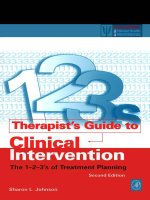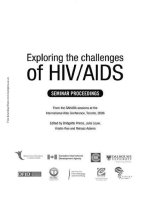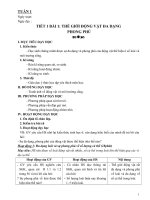5 1 2 the challenges of storm chasing
Bạn đang xem bản rút gọn của tài liệu. Xem và tải ngay bản đầy đủ của tài liệu tại đây (3.63 MB, 14 trang )
Suggested levels for Guided Reading, DRA,™
Lexile,® and Reading Recovery™ are provided
in the Pearson Scott Foresman Leveling Guide.
Earth Science
The Challenges
of Storm Chasing
by Chris Downey
Genre
Expository
nonfiction
Comprehension
Skills and Strategy
• Cause and Effect
• Draw Conclusions
• Monitor and Fix Up
Text Features
•
•
•
•
Captions
Diagrams
Maps
Glossary
Scott Foresman Reading Street 5.1.2
ISBN 0-328-13506-2
ì<(sk$m)=bdfag < +^-Ä-U-Ä-U
Vocabulary
branded
constructed
daintily
devastation
lullaby
Reader
Response
The Challenges
of Storm Chasing
1. What causes Tornado Alley to have lots of storms
during the spring? What effects do these storms have
by that
Chrisarea
Downey
on
of the country?
2. What did you learn about tornadoes from reading
this book? What more would you like to know? Use
a chart like this one to show what you learned and
what more you’d like to learn.
What I Learned
What I Want to Know
pitch
resourceful
thieving
veins
Word count: 1,877
3. What are the base words in the vocabulary words
branded and constructed? Use them in sentences.
4. What information did the map and caption on pages
4 and 5 give you?
Note: The total word count includes words in the running text and headings only.
Numerals and words in chapter titles, captions, labels, diagrams, charts, graphs,
sidebars, and extra features are not included.
Editorial Offices: Glenview, Illinois • Parsippany, New Jersey • New York, New York
Sales Offices: Needham, Massachusetts • Duluth, Georgia • Glenview, Illinois
Coppell, Texas • Ontario, California • Mesa, Arizona
The Most Powerful of All
The rain from thunderstorms provides water for
Earth. Without that water, trees and plants wouldn’t
be able to grow and life wouldn’t be able to exist.
Thunderstorms also have negative aspects. They can
often create strong winds, hail, and lightning. These
things are dangerous and can cause much damage.
However, thunderstorms create one type of weather
that is more dangerous than all of those things:
tornadoes.
Every effort has been made to secure permission and provide appropriate credit for
photographic material. The publisher deeply regrets any omission and pledges to
correct errors called to its attention in subsequent editions.
Unless otherwise acknowledged, all photographs are the property of Scott Foresman,
a division of Pearson Education.
Photo locators denoted as follows: Top (T), Center (C), Bottom (B), Left (L), Right (R),
Background (Bkgd)
Cover: Corbis; 3 Corbis; 6 Corbis; 7 ©Warren Faidley/Weatherstock; 8 ©Warren Faidley/
Weatherstock; 11 Corbis; 12 Corbis; 14 Getty Images; 16 Corbis; 18 ©Jim Reed/Corbis;
20 ©Warren Faidley/Weatherstock; 22 (Bkgd) Corbis, (CR) Comstock Inc.
ISBN: 0-328-13506-2
Copyright © Pearson Education, Inc.
All Rights Reserved. Printed in China. This publication is protected by Copyright,
and permission should be obtained from the publisher prior to any prohibited
reproduction, storage in a retrieval system, or transmission in any form by any
means, electronic, mechanical, photocopying, recording, or likewise. For information
regarding permission(s), write to: Permissions Department, Scott Foresman, 1900 East
Lake Avenue, Glenview, Illinois 60025.
4 5 6 7 8 9 10 V0H3 14 13 12 11 10 09 08 07 06
3
Dangerous storms most often appear in the plains
of the United States. This area is known as Tornado
Alley. Tornado Alley has lots of dangerous storms
because of weather patterns that occur in spring.
This makes spring the best season to spot a tornado,
which is a funnel-shaped cloud of spinning air.
A tornado can leave a path of devastation if it
touches down where there are people and buildings.
But as dangerous as tornadoes are, they are amazing
to look at. A few brave and curious people known
as storm chasers spend their time tracking and
observing these storms.
Chase that storm!
Some storm chasers follow thunderstorms
for scientific study, yet others do it purely for
excitement. Many storm chasers are interested in
weather patterns and meteorology. Meteorology
is the study of the atmosphere. Very few people
actually make a career of chasing storms. Many do
it for the thrill of seeing a tornado and the pleasure
of learning more about these amazing and powerful
weather events.
Tornado
Alley
States such as Oklahoma, Kansas,
Nebraska, Missouri, Arkansas, and
Iowa are usually included in Tornado
Alley. Parts of Texas, Louisiana, Illinois,
South Dakota, Minnesota, and Indiana
are often added too.
4
5
Even with help from weather reports and storm
tracking equipment, a storm chaser must often make
quick choices at a moment’s notice. Some storm chasers
use modern equipment to help forecast a storm’s
possible strength and direction. Satellites, radios, and
laptop computers are important storm-tracking tools.
Even with all of these aids, chasers are often faced
with last-minute choices about when to stay put and
when to move on to another location. This truck
below has radar equipment that storm trackers can
move from place to place to measure information
about the storm at the site.
Thanks to TV shows and movies, many people
think that storm chasing is constant action and
excitement. They might be surprised to find out that
real storm chasing is very different. In fact, one of
the main challenges of chasing a storm is the long
time spent waiting for a possible event. In a very
good year, a chaser can expect a success rate of up
to 10 percent. This means that 90 percent of the
time is spent waiting and looking for storms. Many
chases end up as busts, missions that don’t result in
the chaser seeing a large storm or tornado. A chaser
must be very patient.
6
Modern equipment like laptop computers, video cameras,
radios, and satellites help storm chasers learn where a storm
may happen. This modern equipment also helps capture
images of storms for others to see.
7
Staying Safe
This storm chaser uses a video camera to record the tornado
so he can later study its movement.
8
Storm chasers drive many miles across the United
States in search of storms. Driving in bad weather
can be dangerous, even for an experienced storm
chaser. Rain floods roads, often causing cars to get
stuck or spin out of control. Rain, hail, fog, and pitchblack darkness can make it hard for the driver to see
the road ahead. As chasing becomes more popular,
the roads around storms become more crowded.
First-time chasers without experience make things
even more dangerous.
Some of the newer chasers have been branded
as “renegades” by older chasers. The renegades
start chasing for the excitement of being near a
huge storm. Instead of studying the science of
tornadoes, these chasers speed along roads in search
of excitement and fun. Safety is very important when
following a storm. Chasers who do not use common
sense can make things more dangerous. They risk
their lives and the lives of others just for thrills.
9
Chasers must be careful at all times. Not only
is the weather dangerous, but many chasers carry
expensive equipment to study the storms. This
equipment isn’t easy to replace, so chasers are very
careful that it doesn’t get damaged. They also pay
close attention to their equipment. Those who do
not can become victims to thieving people.
Some chasers take unnecessary risks in order to
see a storm up close. Many seek out supercells. A
supercell is a very powerful type of thunderstorm
that can create tornadoes. Some chasers even go
core punching. This is when a chaser drives through
the center, or core, of a thunderstorm. The core of a
storm has the most violent weather. Core punching
is very dangerous. Many storm chasers refuse
to do it, but it does give the closest view of
any tornadoes that might form. Outside
of the spinning core, areas of hail,
heavy rain, and light rain travel
around the supercell.
,IGHT�RAIN
(EAVY�RAIN
(AIL
The core is the area of a thunderstorm
where the most severe weather
occurs.
#/2%
3TORM�PATH
10
11
Tornadoes can do that?
A storm that may seem scary to you and me can
look beautiful to a storm chaser. Even loud thunder
claps may sound as soothing as a lullaby to a person
who loves studying storms. However, this can be
dangerous for storm chasers. They always have to
remember that storms with lightning, driving rain,
and very high winds are powerful natural events.
The very same storms that chasers hope to see also
threaten their lives.
High winds can flip the chaser’s vehicle or blow
out its windows. Heavy rain and hail can make it
hard to see. Flooding and fog can make traveling
harder and might strand a chaser in the path of a
storm. A careful storm chaser knows to keep the car
or truck in good shape and to watch the sky for any
changes. Most important, a good storm chaser knows
when to back off and seek safety. A resourceful
chaser will plan an escape route from a dangerous
storm before getting close to it.
Thunderstorm
Cool, dry air
Warm, humid air
Tornadoes form when a layer of cold air moves over
a layer of warm air. The lighter air then rises up
through the cold air. This creates a funnel cloud that
rotates as the air masses change places.
12
13
A tornado can have devastating effects on
buildings, property, and land. A tornado with winds
moving with furious speed will rip through a town
and destroy everything in its path. Houses and mobile
homes may be flattened, ripped apart, or carried
away completely. A tornado can even peel the bark
off trees! Such violence and destruction can occur at
any time, as tornadoes touch down here and there
without people being able to tell where and when.
On May 3, 1999, a series of tornadoes with wind
speeds of more than three hundred miles per hour
touched down in Oklahoma. The storms, which
eventually turned north into Kansas, destroyed some
houses and neighborhoods around Oklahoma City.
Tornadoes never approach daintily. You can hear
them coming. Their winds make a very loud roar that
many people compare to the sound of a train. Many
towns have special sirens that will sound a warning
when a tornado is approaching.
Tornadoes can generate winds of more than three
hundred miles per hour. Such powerful winds can
completely destroy buildings.
14
15
When Lightning Strikes
One of the biggest dangers for storm chasers is
lightning. Lightning is a release of electricity in the
atmosphere. Some lightning travels from clouds to
the ground when it strikes. These strikes, also called
lightning bolts, look like veins of light. Another form
of lightning looks like a bright flash.
Lightning is a real threat to storm chasers.
It can strike without warning and with deadly
consequences. Nearly one hundred people are killed
by lightning each year in the United States.
16
No one can be completely safe from lightning.
Still, we can all use common sense in order to reduce
our risk of being hurt by lightning strikes. The
safest place to be when lightning strikes is inside a
building. If you have to be outside during a lightning
storm, stay close to the ground. Keep away from
high places and avoid being near tall objects such as
trees, telephone poles, or power lines. Lightning is
more likely to either strike tall objects directly, or hit
very close to them.
17
It All Began . . .
The Doppler on Wheels can be parked in the path of
a storm so it can gather information while people are
safely out of the way.
18
People started chasing storms for fun in the early
1950s. Roger Jensen, a native of North Dakota, was
one of the first people to follow storms for fun and
to photograph what he saw. Scientist Neil Ward, a
respected tornado researcher, was also one of the
pioneers of storm chasing. Ward was one of the first
storm chasers to apply his observations to science.
He was able to forecast weather changes based on
information recorded while storm chasing.
In the 1960s, the U.S. government constructed the
National Severe Storms Laboratory (NSSL) in Norman,
Oklahoma. The NSSL studies storms and works to
improve severe weather forecasting. Using modern
technology and specially constructed equipment,
scientists there work to collect data about storms.
One type of modern technology that the scientists
in Norman use is termed the “Doppler on Wheels.”
It is a set of trucks carrying portable Doppler
radar units. Doppler radar is usually used by local
meteorologists to track weather changes, but the
Doppler on Wheels is made for a different job. Trucks
that carry the radar units are able to drive very close
to tornadoes and gather data about how they form.
19
And they’re off!
At one time, only weather scientists chased
storms. Now all kinds of people are doing it,
including thrill-seekers and people who like
being around dangerous situations. With more
chasers on the move, there are many more
“chaser convergences” than ever before. A chaser
convergence is when a group of chasers meets in a
safe place on a chase day. Another group, similar to a
chaser convergence, is a chase crowd. A chase crowd
is a large group of chasers who stop on open roads
to watch a storm. These crowds gather in places that
are not safe from storms. By doing so, they make
storm chasing even more dangerous.
People who want
to get into storm
chasing can now
go on guided
tours. These
tours are led by
experienced storm
chasers who
already know the
ropes and will stay
safe.
20
Storm chasing is becoming so widespread that
storm tour groups have formed to cash in on its
popularity. These groups charge people for the
chance to chase storms with a tornado expert. Most
of these tour groups operate in a safe, professional
manner. But some of them are run recklessly enough
that they cause people to question whether they
should be allowed.
Obviously, it is important that storm-chasing tour
groups be conducted by responsible people who
know the dangers involved. Not surprisingly, people
who study storms, such as meteorologists, generally
make the best storm chasers. Meteorologists know
more about what a storm is likely to do, and because
of this knowledge they are able to chase storms
with greater safety and efficiency. For instance,
instead of driving through bad weather to reach a
storm in progress, many meteorologists can position
themselves to catch a storm that is forming.
21
How do they do it?
Good storm chasers know how to reduce their risk
of getting hurt. They plan out their chase ahead of
time, using maps and weather reports. Good storm
chasers also make sure that the car or truck that they
use is in good condition. They drive carefully and
stay alert, avoiding slick or flooded areas. At the first
sign of lightning or very strong winds, a good storm
chaser knows to seek shelter and not put himself or
herself in danger.
Storm chasers face many challenges. In addition
to unpredictable weather, they must also contend
with crowded roads and the growing number of
fellow chasers. Still, many storm chasers feel that
the rewards outweigh the risks. Some of the lucky
ones are able to get as close to a storm as any human
has ever been. Their bravery, in combination with
modern technology, gives us a better understanding
of how dangerous storms work!
Maps and compasses are among the many tools
that good storm chasers use in order to plan the
best and safest storm-chasing routes.
22
23
Glossary
Vocabulary
branded
branded
v. marked by
burning.
constructed
constructed
v. put
together.
daintily
daintily adv. with delicate
beauty.
devastation
devastation n. the act of
laying waste, destroying.
lullaby
lullaby n. soft song sung
to put a baby to sleep.
Reader Response
resourceful adj. good at
thinking of ways to do
things.
1. What causes Tornado Alley to have lots of storms
during the spring? What effects do these storms have
on that area of the country?
thieving adj. likely to
steal.
2. What did you learn about tornadoes from reading
this book? What more would you like to know? Use
a chart like this one to show what you learned and
what more you’d like to learn.
veins n. natural channels
through which water
flows, or the tubes that
carry blood through your
body.
What I Learned
What I Want to Know
pitch
pitch n. a thick, black,
sticky substance made
resourceful
from tar.
thieving
veins
Word count: 1,877
3. What are the base words in the vocabulary words
branded and constructed? Use them in sentences.
4. What information did the map and caption on pages
4 and 5 give you?
Note: The total word count includes words in the running text and headings only.
Numerals and words in chapter titles, captions, labels, diagrams, charts, graphs,
sidebars, and extra features are not included.
24









